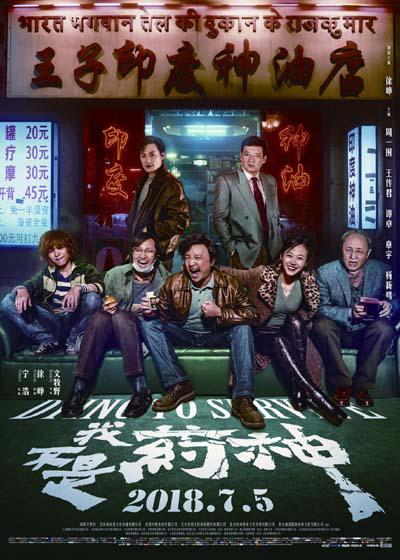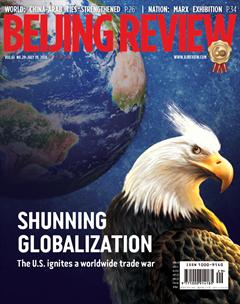Power in Realism
By Li Nan
Forty-five-year-old An Gang has seldom shed a tear while watching films, but Chinas recent blockbuster Dying to Survive brought tears to his eyes on July 5.
The fi lm is about a medication dealer who smuggles unlicensed leukemia medicine from India to provide for poor patients who cannot afford more expensive, offi cially licensed versions in China. The protagonist, Cheng Yong, fi rst became involved in the illegal trade to earn quick money to support his family, and quit the business after making a decent amount. However, following the death of one of his friends due to a lack of affordable drugs, he later resumes the operation.
“My heart hurt when I saw Lu Shouyi, the dying leukemia patient, peeling an orange to thank the protagonist,” An told Beijing Review.“The scene reminded me of my cousin who suffered a similar plight several years ago.”
Ans cousin was diagnosed with small-cell lung cancer. During her treatment, she begged An, then working abroad, to buy Iressa—a medication that interferes with the growth and spread of cancer cells—on her behalf. Yet An was unable to source the drug because at the time Iressa was still undergoing clinical trials.“The last time I saw her, she smiled and peeled an apple for me, just like Lu Shouyi,” An said. Two years after his cousins death, Iressa became reachable in India, and An bought some to help his friends. “But I can never make it up to my cousin,” he said.
The film is based on the true story of Lu Yong, a leukemia patient from east Chinas Jiangsu Province. In the mid-2000s, Lu began taking unregulated but affordable Indian cancer drugs back and helped more than 1,000 fellow sufferers to access them without extra cost. In 2013, he was charged with fraud and traffi cking fake drugs, but he was later freed after fellow patients signed a petition to clear his name.
The film, directed by 33-year-old Wen Muye, has drawn parallels with the 2013 film Dallas Buyers Club directed by Jean-Marc Vallée and starring Matthew McConaughey, which is also based on the true story of a U.S. man who smuggled and sold unregulated drugs to help fellow HIV sufferers in the 1980s.
Although Dying to Survive is not a bigbudget film, it quickly became a sensation after its initial screening at the 2018 Shanghai International Film and TV Festival on June 19. It has also received a rating of nine out of 10 and above on Douban.com, Maoyan.com and Dianying.taotao.com, Chinas top three film review platforms, higher than the 2017 box offi ce hit Wolf Warrior II. Success has also been registered at the box offi ce throughout China, earning 2.01 billion yuan ($302.1 million) in the fi rst nine days following its release, and putting it in pole position to be Chinas highest grossing fi lm of the year.
All of the fi lms investors have also promised to donate 0.3 percent of the films box office revenue to help leukemia suffers, in addition to a 2-million-yuan ($300,612) donation on July 7. For their part, leading actor Xu Zheng and his wife Tao Hong revealed plans to team up with the Beijing New Sunshine Charity Foundation to help children with blood cancer on July 1, the day of the fi lms premiere.
Jiang Wusheng, General Manager of United Entertainment Partners, told Beijing Review that he was deeply moved by the story after seeing the demo and decided to invest in the fi lm immediately. “Dying to Survive represents the peak of Chinas cinematic realism in the last decade,” said Jiang.
Secrets to success
What is behind Dying to Survives box office success? Some believe realism is part of the explanation. “The story is based on a real case, which bridges the worlds of fi ction and reality. It prompts the audience to refl ect on social reality as well as comforting those in similar situations,”Chen Siqin, an assistant research fellow with the Communication University of China, told Beijing Review.
Zhou Xun, an animation director in Beijing, agrees with Chen. “The movie has some similarities to those South Korean films which changed public opinion on certain social issues and improved the countrys legislation.” Zhou said that he has friends who, although they seldom watch movies, have gone to the cinema to watch the fi lm and share their opinions on how to improve Chinas healthcare system.
“If a fi lm can change the society in a positive way, it is unquestionably a good fi lm,” said Zhou. “I hope that more domestic fi lms, be they feature or animation, can encourage moviegoers to think about social issues, rather than just providing entertainment.”
The relatable nature of its characters also account for Dying to Survives success. The filmmakers sought to move away from binary delineations of good and evil, every character instead having their merits and defects which makes the film even more realistic. The main character acts in part out of his own interests and the antagonist comes good at the last critical moment. “Dying to Survive expands the potential for Chinese f ilms with its storytelling,”said Chen.
The exceptional performances of many of the films cast have not gone unnoticed. The producers chose not to employ expensive young stars, whose social media presence often takes precedence over their acting skills. Instead, they invited veteran actors and actresses who made the story authentic and emotive.“Every actor and actress accomplishes his or her mission, expressing humanity and dignity,”said Chen.
“The leading actors, including Xu and Wang Chuanjun, are likely to sweep various acting awards this year,” Wang Yao, an assistant fellow with the Department of Film Studies at Beijing Film Academy, told Beijing Review.
Social progress
Needless to say, Dying to Survive has its fl aws.“The biggest problem with the film is that it demonizes the pharmaceutical company that invented the leukemia medication. It is a pharmaceutical provider that has spent a huge amount of money creating the drug. It is not fair to portray them as the villain,” An said. He added that while the fi lm focuses on the plight of leukemia suffers, it should be noted that without the hand of the market to encourage pharmaceutical producers to invent new drugs, patients would be subject to even more diffi culties and suffering. In his opinion the high price of Chinas drugs is attributable to a problematic price negotiation mechanism.
In fact, China has been working hard to produce and provide affordable medications for those who need them. In 2016, the Chinese Government issued guidelines for the development of the pharmaceutical industry to encourage the production of more affordable drugs. In 2017, the Ministry of Human Resources and Social Security negotiated with international pharmaceutical producers, and adopted 36 new drugs under the national medical insurance system, slashing the prices of the 36 medications by 44 percent on average.
This year, 19 provinces and municipalities added Gleevec, a medication used in the treatment of chronic myeloid leukemia, to its medical insurance list. The price of Gleevec dropped by half, and from May 1, the government removed tariffs on all anti-cancer drugs.
China and India have also formulated specifi c measures for the promotion of China-India pharmaceutical trade cooperation and greater Chinese access to drugs from India. “We believe that stronger pharmaceutical trade cooperation will contribute to the well-being of the people in our two countries,” said Hua Chunying, Spokeswoman for Chinas Ministry of Foreign Affairs, on July 9.

